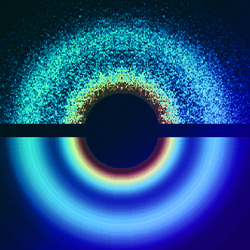Prediction Challenge: Cyclobutanone Photochemistry
 The simulation of photochemical molecular dynamics has been a major challenge to theoretical chemistry because of the need to simultaneously describe quantum mechanical effects of both nuclei and electrons. Numerous advances have been made over the past decade and many would agree that excited state simulations have demonstrated their value in the interpretation of experiments. However, one can question whether these simulations have been unambiguously predictive. True predictive capabilities would pave the way to rational design of light-driven molecular systems, with revolutionary implications for renewable solar energy (directly to electricity or to fuels), bioimaging, optogenetics, and photochemical synthesis. Thankfully, new ultrafast diffraction experiments1 have come on-line which provide both spatio-temporal resolution on the atomic scale, i.e. molecular movies. This provides a novel opportunity – a double-blind test of the accuracy of excited state simulations.
The simulation of photochemical molecular dynamics has been a major challenge to theoretical chemistry because of the need to simultaneously describe quantum mechanical effects of both nuclei and electrons. Numerous advances have been made over the past decade and many would agree that excited state simulations have demonstrated their value in the interpretation of experiments. However, one can question whether these simulations have been unambiguously predictive. True predictive capabilities would pave the way to rational design of light-driven molecular systems, with revolutionary implications for renewable solar energy (directly to electricity or to fuels), bioimaging, optogenetics, and photochemical synthesis. Thankfully, new ultrafast diffraction experiments1 have come on-line which provide both spatio-temporal resolution on the atomic scale, i.e. molecular movies. This provides a novel opportunity – a double-blind test of the accuracy of excited state simulations.
Based on intensive discussions during a CECAM workshop, we have arranged for such a test and challenge the community to predict the results of the experiment and prepare manuscripts for submission to a special issue in The Journal of Chemical Physics. To be considered, submissions must be received before the experimental results are revealed (no earlier than January 2024) and they must include direct predictions of the key experimental observables (details provided below). In the spirit of the challenge, we will be requiring contributors to upload their manuscript to arXiv prior to JCP submission. Upon submission to JCP, authors must then include the pre-print DOI in their cover letter and in their original manuscript (for reference during revisions). We are excited to see the outcome and rooting for the success of the simulations!
1 M. Centurion, T. J. A. Wolf, and J. Yang, Ultrafast Imaging of Molecules with Electron Diffraction, Ann. Rev. Phys. Chem. 73 21 (2022).
Guest Editors
Todd Martínez, Stanford University
Thomas Wolf, SLAC National Accelerator Laboratory
Petr Slavíček, University of Chemistry and Technology, Prague
Graham Worth, University College London
Mario Barbatti, Aix-Marseille University
Basile Curchod, University of Bristol
Sara Bonella, École Polytechnique Fédérale de Lausanne
JCP Editors
David Manolopoulos , University of Oxford
More information:
The experiment will be performed at the SLAC Megaelectronvolt Ultrafast Electron Diffraction facility. A gas sample of about 1 mbar of cyclobutanone will be irradiated with 200 nm light (≈80 fs cross-correlation) and electron diffraction images will be obtained with 150 fs time resolution (FWHM) and 0.6 Å spatial resolution (2π/Smax), with the scattering vector S ranging from 1-10 Å-1. The experiment will be performed at a repetition rate of 360 Hz and the gas sample will be exchanged after each optical/electron pulse pair. Note that the excitation is believed to target a Rydberg (3s) excited state (i.e., n→ 3s) and not the n→π* state (280 nm) which is believed to be the lowest singlet excited state. This is because the oscillator strength of the n→π* state is too low and direct excitation to this state would likely lead to multiphoton transitions. The intensity of the 200 nm excitation light will be kept as low as experimentally feasible (5 μJ) to excite &symp;10% of the molecules and avoid multiphoton excitation. The experiment will collect diffraction images for time delays from -1 ps to 10’s of ps in variable step sizes. The immediate region around time zero (-200 fs to 200 fs) will be scanned with 30 fs stepsize. Longer positive delays will be scanned with step sizes up to several ps. It is very possible that one or more triplet electronic states will be involved in the dynamics. There has been previous theoretical and experimental work on cyclobutanone photochemistry which should inform the simulations, including Refs. 2-5.
Participants can contact Thomas Wolf (Thomas.wolf@slac.stanford.edu) to get added to a Slack workspace. Any questions about experimental details can be posted to this workspace and questions/answers will be available to all participants.
2 M.-H. Kao, R. K. Venkataraman, M. N. R. Ashfold, A. J. Orr-Ewing, Effects of Ring-Strain on the Ultrafast Photochemistry of Cyclic Ketones, Chem. Sci. 11 1991 (2020).
3 E. W. Diau, C. Kotting, A. H. Zewail, Femtochemistry of Norrish Type-I Reactions: II. The Anomalous Predissociation Dynamics of Cyclobutanone on the S1 Surface, ChemPhysChem 2 294-309 (2001).
4 S.-H. Xia, X.-Y. Liu, Q. Fang, G. Cui, Excited-State Ring Opening Mechanism of Cyclic Ketones: A MS-CASPT2/CASSCF Study, J. Phys. Chem. A 119 3569 (2015).
5 L. Liu, W.-H. Fang, New Insights into Photodissociation Dynamics of Cyclobutanone from the AIMS Dynamic Simulation, J. Chem. Phys. 144 144317 (2016).
Please note that papers will be published as normal when they are ready in a regular issue of the journal and will populate on a virtual collection page within a few days of publication. Inclusion in the collection will not cause delay in publication.
How to Submit:
- Please submit through the online submission system.
- Under manuscript type → select Article or Communication, as appropriate
- Under manuscript information → Manuscript classification → select Special Topic: “Prediction Challenge: Cyclobutanone Photochemistry”
